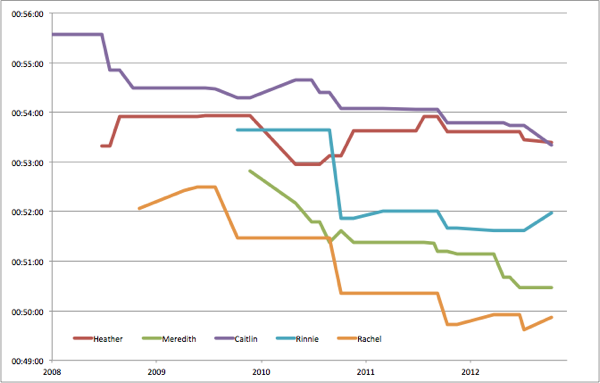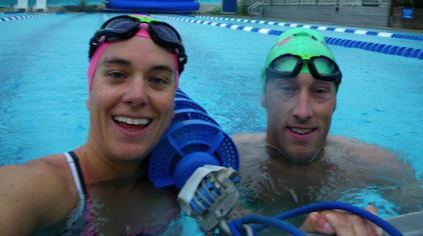On her blog, Heather Wurtele wrote that she was frustrated about her swim time in Kona:
In 2010 I swam a 51 min IM swim in St. George, beating Meredith Kessler out of the water. I also used to be in front of Caitlin Snow out of the water, pretty much guaranteed These two ladies now soundly kick my ass. … Their improvement highlights my stagnation.
Here’s the data that Heather’s statement is based on:

(I put Meredith’s Hawaii time in brackets as she didn’t finish this year after a bike crash.)
Heather’s coach, Paulo Souza, replied with an analysis of the Kona swim times:
- Your time difference to the best time has decreased both in 2011 and 2012
- Your time difference to the most consistent performer in the years you raced Kona (Rachel Joyce) has decreased in 2011 and 2012.
- Your time difference to the best athlete in that list (Mirinda) has also decreased from last year to this year.
He comes to the following conclusion:
I think the data shows your clear progression in the last couple years.
As I have started to analyze swim/bike/run times (in addition to the total finishing times), this discussion inspired me do have a closer look at the data. First, here’s a look at the swim times where Heather was racing with one of the ladies mentioned:

(The table is just a comparison with Heather’s results; of course, the other athletes have more results than these.)
From this table, it looks that the only time Heather was swimming faster than Meredith and Caitlin was St. George 2010, and she was “soundly kicked in the ass” (her words) in this year’s Kona. But what should be considered “normal” .. was St. George the exception or Kona 2012? Another question is what influence the different courses have. Obviously the differences in the swim time largely stem from the fact that Kona (as an ocean swim with swell and currents) is slower that the lake swims in St.George, Canada or Arizona. Also, how accurately a course is measured is also an influence.
I’m trying to account for all of these factors by calculating an adjusted swim time (similar to the adjusted total time I use for my ratings). The adjusted swim times of an athlete can then be averaged to a swim rating. Here is a look how the swim ratings of Heather and the others ladies has developed over the years:

A couple of observations from this graph:
- The red line is mainly horizontal, which means that Heather’s swim rating hasn’t changed much between 2008 and 2012.
- Meredith’s swim rating (green line) has steadily improved from 2010 to 2012, she is about three minutes quicker than Heather (and Caitlin) now
- Caitlin (purple line) has also improved, she used to be two minutes slower than Heather and has improved to be faster by a few seconds. (But nowhere close to “soundly kicking my ass”, at least not in Ironman races.)
- Rinnie (blue line) made a big step (almost two minutes) after her first Ironman, she has been pretty steady since then.
- Rachel (orange line) is the best swimmer of these five athletes, she steadily improved until last year and is pretty steady at a sub-50-minutes rating since then.
All in all, the data agrees more with Heather’s assessment that her swim hasn’t improved, while other athletes managed to get better. Of course, the data is purely looking at the times – other factors such as how much effort was required cannot play a role here. If Paulo’s observation about her improved pool times is correct, maybe Heather can swim a bit harder without sacrificing too much bike or run time, or we can look forward to a breakthrough performance from Heather in one of her future Ironman races. For the next months,I think she correctly predicted when she wrote:
Oh my god, I am going to suffer in the water this winter!!!!! 🙂
Heather, enjoy your off-season!

(Photo from her blog.)
Thorsten,
Please send me the spreadsheet with these calculations and I’ll help you pinpoint the evident flaw you have in your analysis.
Thanks,
Paulo Sousa
Paulo, thanks for having a look. But the analysis is not as simple as a single spreadsheet. I’ll prepare a longer explanation via email and/or my blog.
Comments are closed.